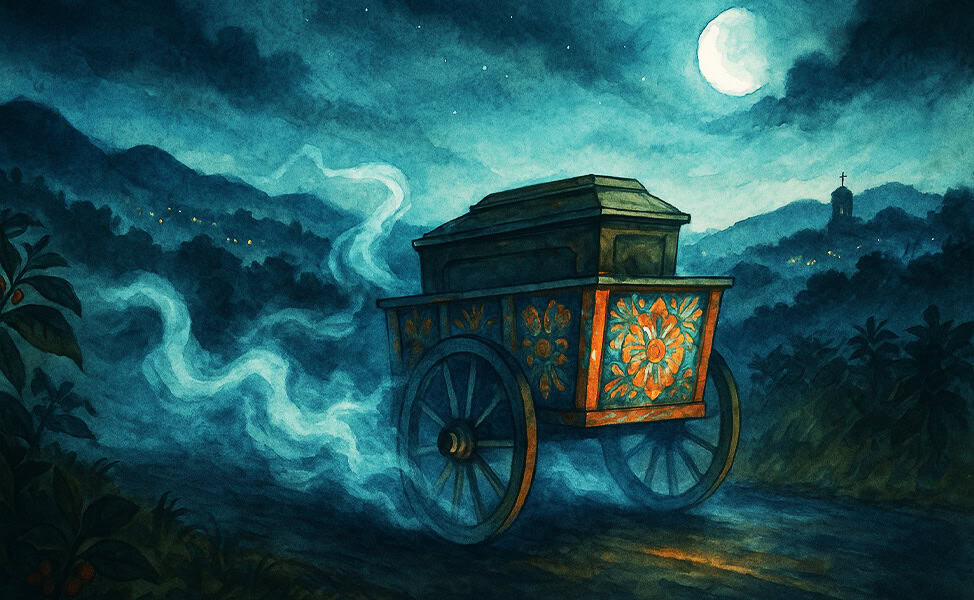Creepy tales are all a part of folklore. Halloween is not considered a traditional holiday in Costa Rica, but the lore here is rich in scary stories. Although few people truly believe in haunts these days, it never hurts to pay attention. It has been said that these tales are based on incidents that took place in the colonial era, and they are repeated as warnings to follow the straight and narrow. Or else…
La Segua
Central America’s own version of the Sirens. Young men (and perhaps some older ones too) would be riding home on their trusty steed after a late night at the canteen or roadhouse. But then, there along the roadside he comes upon a damsel in distress. And she’s quite fetching. Being a chivalrous fellow, the man helps her climb on the back of the horse and and they start off.
Along the way he becomes aware of foul odors and hefty snorting from his passenger. He turns around, and sees that the femme fatal has turned into La Segua, a monster with the head of a putrefied horse.
If he doesn’t succumb to a heart attack, he vows to change his flirtatious ways, settle down and marry the plain but respectable girl next door. He also vows to never help a stranger in need again. It’s a somewhat dubious lesson. Although, to be fair, The Tico Times does not condone picking up hitchhikers.

El Cadejo
Another tale from the colonial era, this story is of a defiant young man whose father decides to teach him a lesson. If the young man continued in his life of sin, the father – who was also a wizard, apparently – promised to turn his son into a dog. And not just any canine but a big, black, hairy dog with red eyes and goat feet.
So a goat-dog, basically. Which is much worse than a regular dog. The creature also is condemned to dragging a chain behind him (did you know leash laws actually started in the colonial period?). The son ignored his pop’s advice and soon he turned into the devil dog, Cadejo.
Many souls swear to have heard Cadejo rattle his chain and growl as they made their way home on rural roads in the dead of night.
The Headless Priest
Gee, life in colonial times must have been wild. There are several versions of headless clerics. Here are some of the most popular versions:
One story features a man of the cloth who had his head lopped off over a married lady in his parish. It wasn’t the hand of the Almighty who smote him but the lady’s husband, who ripped the parson’s noggin from his neck. He killed him on the altar just as he was consecrating the host. The headless priest wanders the country looking for his loss cabeza.
In Cartago, residents allege this ghost appears in the ruins of the cathedral, which was destroyed by an earthquake, rebuilt and destroyed a second time. A vengeful god seems to shake the earth beneath the church each time it gets rebuilt, and the cathedral remains in ruins to this day.
San Ramón has its own version. The priest there loved to gamble and had amassed quite a fortune. He had to make a trip to Nicaragua and secretly buried his hoard under a tree in San Ramón. On his trip, the priest was decapitated. But concerned about his assets, he returned, sans head, to keep an eye on his treasure. To this day he hides in the bushes to see that nobody steals it.
In Patarrá, another headless priest hides in the bushes around the church to scare sinners into changing their ways. Because he is hidden in the foliage he is difficult to see, but churchgoers feel his presence. Another tale tells of a priest who was beheaded by the Inquisition for being a skirt chaser and roams the countryside looking for his head. The question is, how many headless priests reside in Costa Rica? That is some powerful Catholic guilt.
The Oxen-less Cart

This tale too has several versions. Back in 1700s, when San José was just getting settled, it was surrounded by woods. But the trees yielded plenty of timber for the growing town, and part of the woods was reserved for building a church – the most important construction of any community.
However, not everybody was satisfied and one man, on the sly, cut and carried off the wood to make himself a new oxcart. It was to be the sturdiest oxcart in town, and everybody was going to be so jealous about this rad new oxcart. He even thought about painting some sick flames on the side of the cart, but before he had a chance Saint Joseph had his vengeance.
The patron saint of the city took a tough stand against the wood thieves. As punishment, he forced the thief to roam around the country in his cart until the end of time. The oxen, innocent of any wrongdoing, were released. But the oxen-less cart rumbles along night after night. It is said that the man died years ago but his cadaver remains in the cart. The story concludes with a warning that to look at the cart will result in instant death.
Nobody living can claim to have seen the cart without oxen plod by because they were all too afraid to look, but many people claim to have heard it.
La Llorona
La Llorona is a weeping woman who wanders along rivers searching for her lost child. There are several versions of this story, but all center around a young woman who, against family wishes and community standards, had a child outside of marriage. In one version she is a young girl from the country who works in a house in San José. There, she is seduced by the owner of the house, who subsequently rejects her when the woman gets knocked up.
Ashamed and fearful, she returned home to her parent’s disapproval. On a rainy night she threw the baby into the river. Now and forever, La Llorona walks the shores trying to find her infant and make amends. Her cries of remorse are often heard near rivers.
Another version describes her as an Indian maiden who falls in love with a Spanish conquistador. Although they want to get married, her father is against it. But when the maiden gets pregnant, the father throws the baby into a waterfall, where it is carried away. And the tearful Llorona must wander the banks of the country searching for her child.
As far as images go, interpretations of La Llorona might be the most frightening. We did a Google image search for you. Click here if you dare.
The tale hasn’t been forgotten. You can watch the movie “The Curse of La Llorona” and see the legend come to life.
Macho Chingo
Macho Chingo was either a Gringo or a German who liked to saunter around naked in Atenas due to the heat. (In some versions of the tale he inexplicably wears a necktie.) The word macho is used for blondes with light complexions, while chingo is slang for naked. The foreigner still likes amble through the streets of Atenas in his birthday suit, and there’s even a hill named after the Macho Chingo. But now he’s a ghost. And not just any ghost … a naked ghost.
El Puente de Piedra
In Grecia, there is a bridge called Puente de Piedra. Satan constructed this bridge at the behest of a wily Costa Rican who needed to cross the river. The Costa Rican, with no faith in MOPT to get the job done, chose instead to barter his soul if Beezlebub would build a bridge of stone. But the devil had to finish it before the cock crowed at dawn.
The devil got busy hauling stones from the river and stacking them to form the bridge, and when he had only one more space to fill, the Tico grabbed a rooster that wandered nearby and squeezed it, making it crow. Thus he cancelled the contract, and outwitted the Dark Lord Satan himself. By looking up at the bridge from down below you can see the space where the last stone should have gone.
This story was originally published on Oct. 28, 2013.







